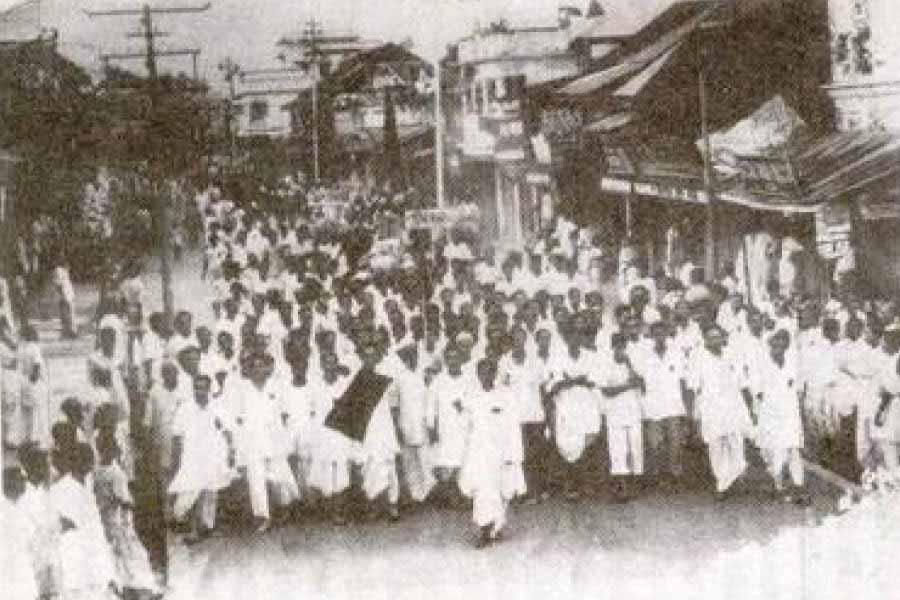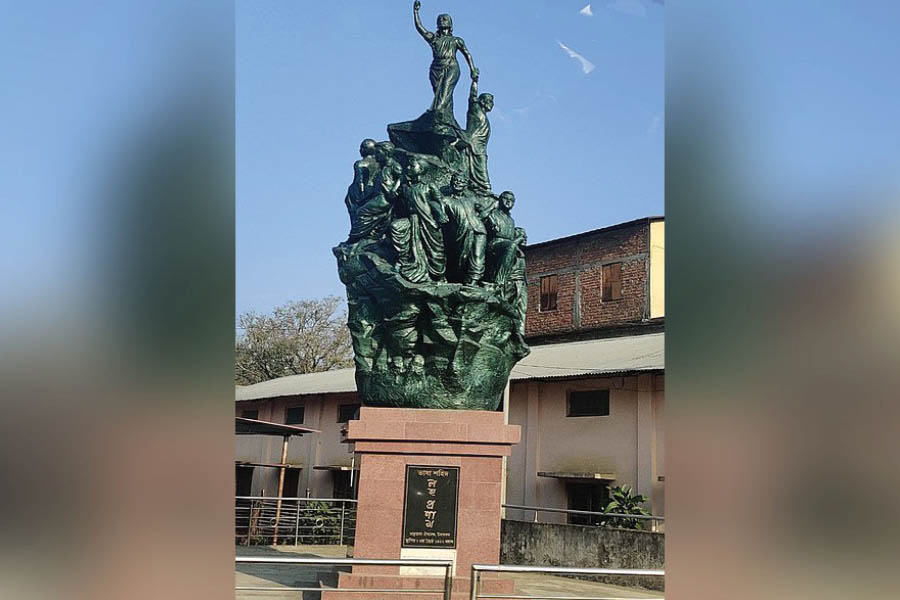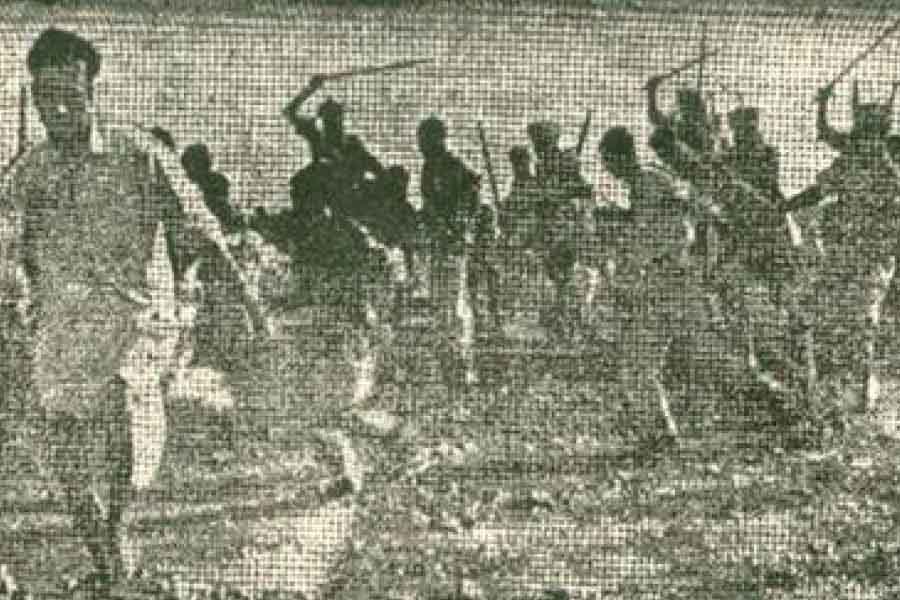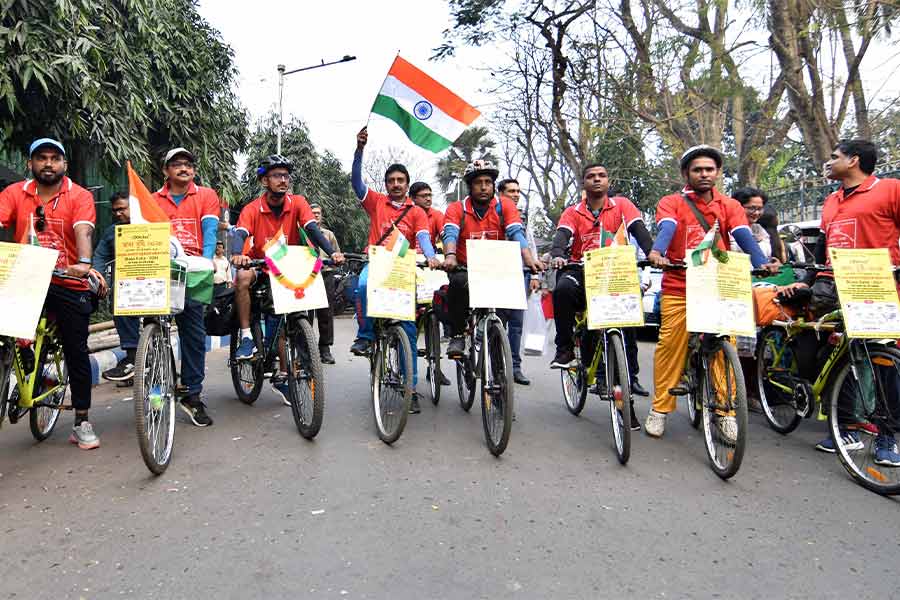In 1947, as the British prepared to depart India, the division of the subcontinent on religious lines was set in motion. One of the territories which came under this unfortunate division was Sylhet of East Bengal. To decide the question of staying with the Indian Union or joining the East Pakistan province of the newly formed state of Pakistan, a plebiscite was held.
A Muslim majority district, Sylhet voted for accession to East Pakistan. But thanks to the efforts of Abdul Matlib Majumdar, an Indian Congress leader, the eastern-most subdivision of Karimganj stayed with India, while the rest of Sylhet joined East Pakistan.

Procession in Silchar on May 20, 1961
Post-1947, Karimganj became a part of the district of Cachar in the Indian state of Assam, roughly synonymous with the Barrack river valley. Due to its history, and in contrast with the rest of Assam state, Cachar had an overwhelmingly Bengali-speaking population – almost equally split by two major religions, Hinduism and Islam. By the early-1950s, East Pakistan was on the boil with the Bengali-speaking populace up in arms against the West Pakistani administration’s diktat of imposing Urdu as the official language on all of Pakistan. The embers of that fire also spread to Barak Valley.
In April, 1956, at a meeting of the Assam Pradesh Congress Committee, a resolution was adopted to introduce Assamese as the only official state language of Assam. It led to disquiet in the Barak valley region. By October, a bill to the above effect was tabled in the Assembly and was passed in the same month. Protests now erupted across Cachar district which had an almost 80 per cent Bengali-speaking population.
This decision by the Assam Congress government was in stark contrast to the Language-based State Reorganisation Committee decision of 1956 which had clearly stated that a state could adopt a single official language only if more than 70 per cent of a state’s inhabitants spoke only that language. This was not the case in Assam but the state government still decided to go ahead with it.
In February, 1961, the Cachar Gana Sangram Parishad (Peoples’ Resistance Committee) was formed. The Parishad now took the lead in organising protests across the Barak valley. In April that year, a decision to launch a two-week long peaceful protest march across the district was taken. At the culmination of this protest march, Rathindranath Sen, a leading figure of the resistance movement, declared that if the state government did not acknowledge Bengali as an official language of the state, a mass hartal (strike) and non-violent satyagraha would be launched. The date decided was May 19.
The night before D-Day, the state struck at the resistance with all major Parishad leaders arrested and thrown behind bars. A week earlier, soldiers of Assam Rifles, Madras Regiment and the CRPF marched into Silchar station.
As dawn broke on May 19, despite having lost their leaders, the protest begun in earnest. Pickets were placed in front of government offices, courts and railway stations. At Silchar station (known as Tarapur back then), not a single ticket was sold for the 5.40am train. Despite the protests remaining peaceful, lathicharge by government forces at several places left more than 200 injured.
Around 2.30pm, a truck was passing the Silchar station carrying some detained protesters. Seeing their comrades arrested, the protesters at the station started raising loud slogans.
The Assam police contingent manning the station now started indiscriminate lathicharge and shelling tear gas. Then, with little real threat from unarmed protesters, 17 gun rounds were fired in just seven minutes. When the smoke cleared, nine protesters lay dead. Two more died later. The youngest among the dead was 16-year old Kamala Bhattacharya.
The next day, a massive procession walked out with the bodies of the martyrs. The incident led to widespread condemnation of the state government’s actions across the country. Put on the backfoot, the Assam government formed an inquiry commission under the auspices of the chief justice of Guwahati High Court.

Statue of martyrs of Bengali Language Movement of Barak valley
At the intervention of Union home minister Lal Bahadur Shastri, the protests were called off on June 17, 1961. Thanks to Shastri’s diligent efforts that the controversial circular was withdrawn and Bengali was formally adopted as the official language of the Cachar district (Cachar, Karimganj and Hylakandi districts at present).
As recently as 2013, the Tarun Gogoi government of Assam had issued a circular stating use of Assamese as the only official language of Assam. Strong protests in the Barak valley districts forced the withdrawal of the circular.
In the history of the world, the Bengali language remains unique. Speakers of this language have twice sacrificed their lives en masse to retain the rights to use their mother tongue. The first of the two, February 21 is now recognised and celebrated as the International Mother Language Day. May 19 and the people who sacrificed their lives that day though remain largely in obscurity.
Maybe the time has come for India to consider recognising this day as its own Mother Language celebration day.

